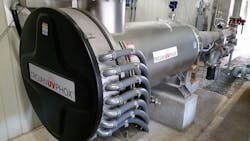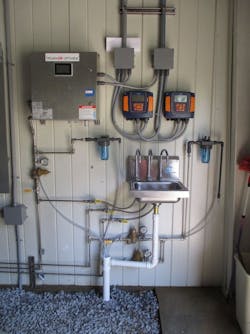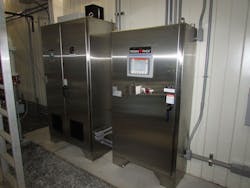Advanced Oxidation Process for 1,4-Dioxane Removal
Cost: $1.5 million
Location: Oakdale, N.Y.
Year: 2018-12-01
Size: 1,200 gpm
Owner: Suffolk County Water Authority
Designers: Suffolk County Water Authority, Trojan UV, Dvirka & Bartilucci
Contractor: Philip Ross Ind.
The Suffolk County Water Authority (SCWA) is an independent public-benefit corporation operating under the Public Authorities Law of the State of New York. Serving approximately 1.2 million Suffolk County residents, the authority operates without taxing power on a not-for-profit basis.
In 2017, SCWA completed the construction of the first advanced oxidation process (AOP) treatment system for drinking water in New York.
The ultraviolet-hydrogen peroxide (UV-H2O2) AOP system was built to address concerns over the contaminant 1,4-dioxane. Since AOP is the only treatment method shown to effectively remove 1,4-dioxane, regulatory approval was a critical step. The full-scale system was designed to provide treatment for 1,4-dioxane in a 1,200-gal-per-minute production. Full-scale testing confirmed it provides greater than 2.2-log destruction of 1,4-dioxane.
“[The goal was] to develop a drinking water treatment system to cost-effectively remove the emerging contaminant 1,4-dioxane from groundwater at the Suffolk County Water Authority’s Commercial Boulevard, Central Islip well field,” said Scott H. Meyerdierks, lead civil engineer for SCWA. “The treatment system also needed to work within our existing treatment processes. 1,4-Dioxane is a synthetic chemical used as a solvent and chlorinated solvent stabilizer for industrial chemicals. It can also be found in household products such as deodorants, shampoos, toothpastes and mouthwashes. There is currently no chemical-specific federal or New York State regulation for the compound.“
We take care of our clients because where we are now is as a result of these. Trust us, if you are looking for a “complete term paper for me” we'll never disturb you. Get premium quality initial content at affordable prices. Our intention is to assist our clients and cultivate long-trustworthy relationships.
The project faced many challenges from the start. The regulatory framework for compliance for an AOP system needed to be developed, including operating procedures, process control parameters, sampling and monitoring requirements, and general system design. These issues were addressed, the requirements were defined and SCWA was able to obtain full-scale design approval for the UV- H2O2 AOP system.
“As the first such system to be reviewed and approved in New York State, the regulatory framework for compliance for an AOP system needed to be developed, including operating procedures, process control parameters, sampling [and] monitoring requirements and general system design,” Meyerdierks said. “These issues were addressed and requirements for the system were defined [by] working in conjunction with the New York State Department of Health (NYSDOH) and the Suffolk County Department of Health Services (SCDHS). SCWA obtained full-scale design approval for the UV- H2O2 AOP system.”
The process itself is different from conventional water treatment processes. Advanced oxidation refers to any process that produces hydroxyl radicals (•OHs). •OHs are powerful oxidants able to destroy 1,4-dioxane and other contaminants. In the AOP system built by SCWA, •OHs are generated by the interaction hydrogen peroxide and UV light.
Important considerations for AOP photochemistry needed to be addressed in the system design and operational plan. The first was that the reaction between UV and peroxide has low efficiency, resulting in peroxide carryover from the UV reactor. The second was that although •OH radicals are extremely powerful, they may not completely oxidize the target contaminant, and byproduct compounds can be formed.
Though control of the peroxide dose is critical to contaminant destruction in AOP, U.S. EPA-approved analytical methods do not yet exist. The project included testing of an online analyzer and comparative testing of several commercially available field test kits with various reagent chemistries.
Experiments conducted during full-scale trials were designed to confirm the accuracy and reliability of the methods, and evaluate their ability to be used for process control. Results were submitted, and a full-scale protocol for peroxide control in AOP was developed.
For the byproducts, NYSDOH and SCDHS developed the sampling plan for the operational AOP system, which included aldehyde, carboxylic acids and assimilable organic carbon (AOC) sampling across the treatment train. SCWA conducted a matrix of experiments designed to look at the effect of process variables on byproduct formation and to look for potential sources of error due to analytical methods.
It was understood going into the project that the AOP system would not be able to be placed in service without first undergoing extensive challenge testing. Provisions were made so the finished system could be tested at full design flows for extended periods of time without pumping to the system.
Full-scale start-up trial plans were developed and completed during the summer of 2017. The tests consisted of a three-by-three matrix of full-scale trials, using three UV intensity intensities and three peroxide doses. Sampling across the treatment train confirmed the destruction of 1,4-dioxane and addressed the formation and fate of byproducts, as well as peroxide impacts on granular activated carbon.
The final project submitted to NYSDOH and SCDHS was a standard operating procedure (SOP) for an AOP system. The SOP addressed regulatory concerns related to system operation, process control and SCADA integration, and system alarms. It serves as a framework for future AOP systems in New York.
“SCWA is extremely satisfied with the end result: The project represented a major contribution to drinking water treatment in New York State. It allowed SCWA, NYSDOH and SCDHS to work together to confirm the effectiveness of UV-H2O2 AOP for 1,4-dioxane treatment, design and establish the operational framework for AOP, and work with local mechanical contractors and consultants to build the first system. As the interest in AOP grows, this system will serve as an important source of information for other water providers on Long Island,” Meyerdierks said.
Meyerdierks’ findings from the project and project experiences have been shared with the drinking water community at conferences, training classes and during onsite tours. It will continue to use the findings to provide even better AOP systems in the future.
“The SCWA is very proud to be taking a lead role in addressing one of the most pressing emerging contaminant threats on Long Island—the synthetic chemical 1,4-dioxane,” said Jeffrey W. Szabo, SCWA CEO. “As always, we will take whatever actions are necessary to continue to provide high-quality drinking water to all of our customers.”
Project Year: 2018-12-01Contractor: Philip Ross Ind.Designers: Suffolk County Water Authority, Trojan UV, Dvirka & BartilucciOwner: Suffolk County Water AuthorityLocation: Oakdale, N.Y.Cost: $1.5 millionSize: 1,200 gpm

